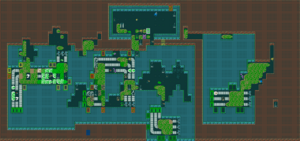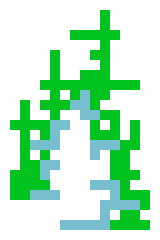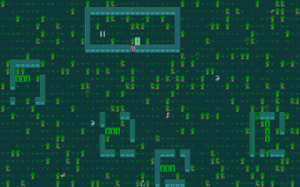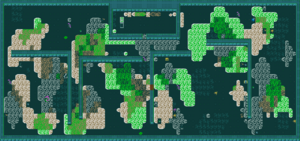Golgotha
Shrouded in the rotting jungle are the mouths of the rust-caves of Golgotha, chrome's graveyard.
Golgotha is an early game dungeon that the player is sent to as part of the first quest for the Barathrumites, "More Than a Willing Spirit." The structure only occupies the center zone of the parasangAn area made of 3x3 screens, which is represented as one tile on the overworld map.; outskirts both above and underground generate as normal ![]() jungle and subterranean jungle zones, respectively.
jungle and subterranean jungle zones, respectively.
| Spoiler Warning: This article contains information normally only found in the course of advancing the main quest line. |
Floors
Surface
Strata: 0
The outside of Golgotha appears as a jungle level with one sealed central building and four randomly placed outbuildings, each containing a row of three ![]() slimy shafts. The central building contains a
slimy shafts. The central building contains a ![]() deep shaft that leads directly to the bottom of Golgotha, and a
deep shaft that leads directly to the bottom of Golgotha, and a ![]() control switch that will unlock the door from inside.
control switch that will unlock the door from inside.
When ready, the player can jump down one of the slimy shafts to the first floor.
One advanced strategy is to ![]() phase,
phase, ![]() burrow,
burrow, ![]() teleport, or
teleport, or ![]() mine your way through the
mine your way through the ![]() tarnished chrome directly into the central building, and jump straight down the elevator shaft- but your character cannot survive the fall without special preparation.
tarnished chrome directly into the central building, and jump straight down the elevator shaft- but your character cannot survive the fall without special preparation.
Trash chutes

Strata: 1, 2, 3, 4
The next four floors are all randomly generated in the same way: the player drops in from a shaft in front of a set of ![]() conveyor drive units driving -conveyor belts. The player must then choose how to make their way to the next set of slimy shafts leading down: whether by standing and fighting to clear an area, or potentially by riding the conveyor belt as quickly as possible to the next level while dodging hazards. Whatever strategy is used, the player may have to confront:
conveyor drive units driving -conveyor belts. The player must then choose how to make their way to the next set of slimy shafts leading down: whether by standing and fighting to clear an area, or potentially by riding the conveyor belt as quickly as possible to the next level while dodging hazards. Whatever strategy is used, the player may have to confront:
![]() green jells,
green jells, ![]() brown jells,
brown jells, ![]() black jells,
black jells, ![]() sewage eels,
sewage eels, ![]() Glow-wight cultists of Agolgut,
Glow-wight cultists of Agolgut, ![]() giant beetles,
giant beetles, ![]() beetlebums,
beetlebums, ![]() spark ticks,
spark ticks, ![]() electric snails,
electric snails, ![]() agolmaggots,
agolmaggots, ![]() spitting slugs,
spitting slugs, ![]() chute crabs,
chute crabs, ![]() eyeless crabs,
eyeless crabs, ![]() rustaceans,
rustaceans, ![]() voiders,
voiders, ![]() quillipedes,
quillipedes, ![]() girshlings,
girshlings, ![]() agolflies,
agolflies, ![]() agolzvuvs,
agolzvuvs, ![]() jilted lovers,
jilted lovers, ![]() dreadroots,
dreadroots, ![]() steaming vents,
steaming vents, ![]() sparking vents,
sparking vents, ![]() scratched vents, and
scratched vents, and ![]() fuming vents.
fuming vents.
The Cloaca
Stratum: 5
In contrast to the quickly moving conveyor belts and hazards of the trash chutes, the Cloaca is a relatively static area full of ![]() trash and sewage. The player will encounter one rare
trash and sewage. The player will encounter one rare ![]() chest, a dysfunctional waydroid, and the unique creature
chest, a dysfunctional waydroid, and the unique creature ![]() Slog of the Cloaca. Whether Slog is friend or foe depends on the players reputation with Mollusks. Mutants with a good faction relationship can learn the Cloaca Surprise through preforming the water ritual with Slog, using one dram of
Slog of the Cloaca. Whether Slog is friend or foe depends on the players reputation with Mollusks. Mutants with a good faction relationship can learn the Cloaca Surprise through preforming the water ritual with Slog, using one dram of ![]() slime. Alternatively, Slog can be killed, and their corpse butchered to obtain
slime. Alternatively, Slog can be killed, and their corpse butchered to obtain ![]() Slog's annunclus.
Slog's annunclus.
Preparation
Players should come prepared to run the entire dungeon, since floors in Golgotha cannot be ascended by normal means once the run has begun.
Strategies for preparing for Golgotha's hazards may include:
 honey or
honey or  yuckwheat stem for disease prevention
yuckwheat stem for disease prevention- A source of healing, such as
 witchwood bark or
witchwood bark or  salve injectors
salve injectors - Explosives, a
 flamethrower, or other means to clear pools of sewage
flamethrower, or other means to clear pools of sewage - Neutral reputation with the Mollusks faction
- Precognition via the
 Precognition mutation or
Precognition mutation or  sphynx salt injectors
sphynx salt injectors - A recoiler
- Rustproof equipment, such as
 eyeless crab shells,
eyeless crab shells,  salthopper mandibles and
salthopper mandibles and  puma chitin vests or Lacquered equipment
puma chitin vests or Lacquered equipment
Trivia
- Before game version 202.78, the strata below the Cloaca were named: Fetid pools (strata 6-8), Deep Cells (strata 9-14), and Oubliette (stratum 15). However, these deeper levels were procedurally generated, using the generic 'ruins' tiles and layout, and were populated principally by creatures found elsewhere in Golgotha, as well as the tier-appropriate spawns of a ruins zone for that z-level. They were not connected to the levels above with stairs, and as such, were inaccessible without a
 spiral borer or similar means of digging downwards. These strata have since been replaced with generic subterranean caves.
spiral borer or similar means of digging downwards. These strata have since been replaced with generic subterranean caves.


